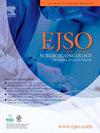Pre-treatment S-index as a promising prognostic indicator of treatment response and survival in patients with synchronous colorectal liver metastases: A retrospective multi-center study
IF 2.9
2区 医学
Q2 ONCOLOGY
引用次数: 0
Abstract
Background
Patients with synchronous colorectal cancer liver metastasis (CRLM) often face sub-optimal outcomes from systemic therapy or resection. This study investigates the prognostic value of the pre-treatment S-index, a reliable non-invasive marker for liver fibrosis, for outcomes in synchronous CRLM patients.
Methods
This study included two populations of patients with synchronous CRLM: one population undergoing resection and another population receiving systemic therapy for unresectable CRLM. Pre-treatment S-index levels were assessed from blood samples. Patients were categorized into high and low S-index groups, and comparisons were made regarding outcomes: progression-free survival (PFS), early post-operative recurrence and fibrosis in liver metastases in the resection population, and treatment response in the systemic therapy population. Multiplex immunohistochemistry/immunofluorescence (mIHC/IF) was used to investigate the distribution of immunosuppressive T-cell subsets in liver metastases.
Results
For synchronous CRLM patients receiving resection (n = 1000), patients with high preoperative S-index demonstrated significantly worse PFS both before (HR = 1.556, 95 % CI: 1.255–1.929; P < 0.001) and after IPTW-adjusted Cox proportional hazards regression analysis (IPTW-adjusted HR = 1.439, 95 % CI: 1.094–1.894; P = 0.036). High S-index patients also exhibited an elevated risk of early recurrence, both before and after adjustment (OR = 1.556, 95 % CI: 1.255–1.929, P < 0.001; IPTW-adjusted OR = 1.439, 95 % CI: 1.094–1.894, P = 0.009). For synchronous CRLM patients receiving system therapy (n = 123), a high pre-treatment S-index (OR = 34.691, P = 0.005) was a significant predictor of progression disease in multivariate analyses. Further, the S-index showed an AUC of 0.814 (95 %CI: 0.762–0.866, P < 0.001) for detecting fibrosis in liver metastases, with a specificity of 0.928. mIHC/IF analysis revealed that inhibitory T cells, especially CD4+PD1+ T cells and CD4+FOXP3+ T cells, were significantly elevated in the liver metastases of the high S-index group.
Conclusion
This study contributed valuable evidence regarding pre-treatment S-index for association with outcomes among synchronous CRLM patients receiving resection or system therapy. Furthermore, it underscores a significant association between a high S-index and the presence of fibrosis in liver metastases, as well as more infiltration of immunosuppressive T cells in the tumor.
治疗前s指数作为同步结直肠肝转移患者治疗反应和生存的预后指标:一项回顾性多中心研究
背景:伴有同步性结直肠癌肝转移(CRLM)的患者在接受全身治疗或切除后,往往面临预后不佳的问题。本研究探讨了治疗前s指数(一种可靠的非侵入性肝纤维化指标)对同步CRLM患者预后的预测价值。方法本研究包括两组同步CRLM患者:一组接受切除,另一组接受不可切除的CRLM全身治疗。通过血液样本评估治疗前s指数水平。将患者分为高s指数组和低s指数组,并对结果进行比较:无进展生存期(PFS),切除人群的早期术后复发和肝转移纤维化,以及全身治疗人群的治疗反应。采用多重免疫组化/免疫荧光(mIHC/IF)技术研究肝转移灶中免疫抑制性t细胞亚群的分布。结果在同步行切除的CRLM患者(n = 1000)中,术前s指数高的患者在术前(HR = 1.556, 95% CI: 1.255 ~ 1.929; P < 0.001)和经iptwr校正的Cox比例风险回归分析(iptwr校正HR = 1.439, 95% CI: 1.094 ~ 1.894; P = 0.036)均表现出较差的PFS。调整前后,高s指数患者的早期复发风险也较高(OR = 1.556, 95% CI: 1.255-1.929, P < 0.001;调整iptwr后OR = 1.439, 95% CI: 1.094-1.894, P = 0.009)。在接受系统治疗的同步CRLM患者(n = 123)中,在多变量分析中,高治疗前s指数(OR = 34.691, P = 0.005)是疾病进展的显著预测因子。此外,s指数检测肝转移灶纤维化的AUC为0.814 (95% CI: 0.762-0.866, P < 0.001),特异性为0.928。mIHC/IF分析显示,高s指数组肝转移灶中抑制性T细胞,尤其是CD4+PD1+ T细胞和CD4+FOXP3+ T细胞显著升高。结论本研究为同步CRLM患者接受切除或系统治疗的治疗前s指数与预后的相关性提供了有价值的证据。此外,它强调了高s指数与肝转移中纤维化的存在以及肿瘤中免疫抑制性T细胞的更多浸润之间的显著关联。
本文章由计算机程序翻译,如有差异,请以英文原文为准。
求助全文
约1分钟内获得全文
求助全文
来源期刊

Ejso
医学-外科
CiteScore
6.40
自引率
2.60%
发文量
1148
审稿时长
41 days
期刊介绍:
JSO - European Journal of Surgical Oncology ("the Journal of Cancer Surgery") is the Official Journal of the European Society of Surgical Oncology and BASO ~ the Association for Cancer Surgery.
The EJSO aims to advance surgical oncology research and practice through the publication of original research articles, review articles, editorials, debates and correspondence.
 求助内容:
求助内容: 应助结果提醒方式:
应助结果提醒方式:


